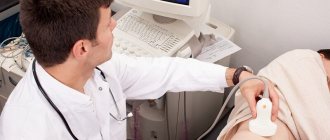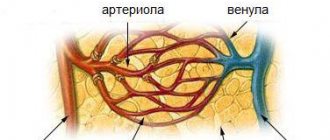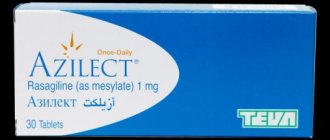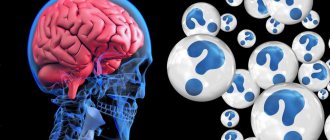Exelon patch - TTS (transdermal therapeutic system). Its manufacturer is the pharmaceutical company Novartis Pharma Stein AG (Switzerland) and Novartis Pharma GmbH (Germany). Neurologists at the Yusupov Hospital prescribe the Exelon patch as part of complex therapy for Alzheimer's disease. The transdermal therapeutic system (TTS) contains 9 mg of the main active ingredient rivastigmine and auxiliary ingredients:
- D,L-α-tocopherol;
- Methyl methacrylate and butyl methacrylate copolymer;
- Acrylic acid copolymer.
The adhesive layer consists of silicone copolymer, dimethicone (silicone oil), D,L-α-tocopherol. Exelon TTC has an anticholinesterase effect.
Description of the drug
Alzheimer's disease is a pathology of the nervous system , one of the most common forms of dementia. In other words, this disease is called “senile dementia” and in most cases it begins to develop in older people over the age of 50, although there are also earlier cases of diagnosing the disease.
The drug called TTS "Exelon" is found both in injection form and in tablet form, as well as in the form of patches. Compared to other forms of release, the patch has much fewer unwanted side effects, and during studies it was noted that this form has a lower incidence of negative consequences.
The Exelon patch is a kind of transdermal therapeutic system (TTS). The main active ingredient of the drug is called rivastigmine. It is precisely because of this that the patch inhibits the enzyme cholinesterase inside the patient’s brain cells. While wearing the patch, the medicinal component gradually penetrates the body and the enzymes butyrylcholinesterase and acetylcholinesterase are temporarily blocked due to their selective suppression.
The active substance of the drug functions in the body for approximately 9 hours, and then the enzymes begin to return to their original levels. In pharmacies you can buy patches that contain 9, 18 and 27 milligrams of the main component. The patch is round in shape, white, with a beige backing. The area of the main contact surface is approximately about five square cm. The excipients of the drug include alpha-tocopherol, methyl methacrylate, butyl methacrylate, acrylic copolymer, silicone copolymer and silicone oil, located directly on the adhesive layers of the patches.
What are generics
Often, the patient’s relatives have a question about which drug is better to take: memantine or noogerone. Here it must be said that akatinol is the first drug in this group of drugs, unique, all other drugs - noodzheron, alzeym, memaneurin - are generics, i.e. akatinol derivatives. These drugs are produced by other pharmaceutical companies. In terms of their chemical formula, these drugs are identical. Here it is necessary to take into account the individual characteristics of the patient, how he tolerates treatment with this drug, as well as the material costs of treatment.
A generic is a generic drug that is a reproduction of the original drug, the active substance of which has expired patent protection. May differ from the original drug in the composition of excipients. The only necessary requirement for generics is proven pharmaceutical, biological and therapeutic equivalence.
The advantages of generics are low cost (due to the absence of development costs, clinical trials, etc. and licensing fees), as well as extensive experience in the practical use of the drug.
If we compare the cost of all drugs, the cheapest treatment will be rivastigmine, followed by memantine hydrochloride, and the most expensive treatment will be galantamine. Considering that cholinesterase inhibitors (galantamine and rivastigmine) can be combined, if necessary, with NMDA receptor antagonists (memantine hydrochloride), the combination of rivastigmine + memantine hydrochloride will be cheaper than the combination of galantamine + memantine hydrochloride.
Pharmacological properties
Rivastigmine is the main drug component and is a selective inhibitor of cholinesterase in the human brain. The substance allows you to slow down the processes of destruction of acetylcholine produced by functionally preserved neurons, and also, in addition, allows you to improve the processes responsible for synaptic transmission.
The use of the drug helps to increase the level of acetylcholine within the hippocampus and cerebral cortex, thereby improving cholinergic transmission. Due to the fact that most dementia and decline in cognitive functions due to illness are associated, as a rule, with a lack of acetylcholine, it turns out that the medicine helps to normalize the functioning of the human nervous system. In addition, there is information that the drug reduces the synthesis of beta-amyloid, and this, in turn, prevents the appearance of harmful amyloid plaques, which are one of the main signs of the development of pathology.
Indications and contraindications for use
Despite the fact that the use of a drug in modern medicine is far from uncommon, its indications for use are still quite rare. These include:
- mild dementia associated with the disease;
- moderate dementia;
- the presence of functional or cognitive disorders.
The drug is used in the form of a patch both in the early stages of the development of the disease and in the immediate presence of the disease.
The use of the drug "Exelon" is prescribed exclusively by the attending physician after a thorough examination of the patient. You cannot make a decision about using this medicine on your own. It must be borne in mind that only the attending physician can advise the use of the Exelon patch. The instructions for its use must also contain all detailed recommendations on the correct use of the drug.
In most cases, therapy begins with the lowest dosage, about 4.6 milligrams per day. Only if the use of the drug after several weeks has not caused any deterioration in the functioning of the patient’s body, has a good effect and no harmful or undesirable effects have been diagnosed, then the dosage is usually increased. In cases where the use of a drug gives a clearly positive result on the body, the duration of therapy can be several months or more.
Sometimes the use of a patch is replaced with injections, similar tablets or other medications. If therapy needs to be interrupted for certain reasons, then it is resumed, again starting with a small dosage of the active component of the drug.
Contraindications to the use of the Exelon patch are as follows:
Hypersensitivity to substances from the carbonate group.
- Hypersensitivity to the main active substance of the drug (rivastigmine) and its side components.
- History of convulsive syndrome.
- The medicine in the form of Exelon patches should be prescribed with extreme caution to those people who suffer from attacks of bronchial asthma or have another similar respiratory disease.
- The presence of acid-related diseases of the gastrointestinal tract.
- Sick sinus syndrome.
- The patch should be used with extreme caution by people weighing less than 50 kilograms, as this increases the risk of side effects or overdose.
- Liver dysfunction.
- The patient is predisposed to urinary obstruction.
- The use of the patch by women during lactation or pregnancy is not recommended, although studies have not yet been conducted that clearly confirm both the danger and harmlessness of the medicine for the organisms of both the child and the mother.
Akatinol memantine, noodgerone
The therapeutic effect of memantine is quite broad and includes neuroprotective effects, a decrease in the severity of cognitive and motor impairments, and a possible decrease in the severity of emotional and affective disorders. Memantine is believed to have antidepressant effects.
It is recommended to begin treatment with Akatinol memantine by prescribing the minimum effective dose. Adults with dementia - during the first week - 2.5 - 5 mg / day (in the morning), during the second week - 10 mg / day (5 mg each in the morning and evening), during the third week the daily dose is 15 mg (10 mg in the morning and 5 mg in the evening). From the fourth week the daily dose is 20 mg. The maximum daily dose is 30 mg/day. The approximate maintenance dose is 10-20 mg/day. If the interruption in treatment with memantine is less than 5 days, the drug can be started with the previous dose, otherwise treatment is resumed with a minimum dose of 2.5 - 5 mg per day.
Treatment regimen: 1st week - 5 mg/day in the morning, 2nd week - 10 mg/day (5 mg in the morning and 5 mg in the evening), 3rd week - 15 mg/day (10 mg in the morning and 5 mg in the evening), 4th week - 20 mg/day (10 mg in the morning and 10 mg in the evening).
Akatinol memantine is taken orally during meals, without chewing and with liquid. The daily dose is evenly divided into several doses throughout the day. The last dose of akatinol memantine is recommended to be taken before dinner. After taking the evening dose, some patients may experience difficulty falling asleep, then the second dose of the medication is postponed to lunchtime.
Possible complications and side effects
Most medical reviews say that complications and possible negative side effects in people undergoing treatment with Exelon appear quite rarely, especially when using patches in the form of the drug. However, exceptions are always possible and there is a certain list of disorders that may well appear with regular use of the medicine. These include:
Possible fainting, depression, anxiety, delirium, headaches and sometimes even hallucinations.
- The most common complication associated with the use of a medicine called Exelon is disruption of the digestive tract. It is accompanied by pain in the abdomen, may begin to feel sick, and may cause dyspepsia or diarrhea. In quite rare cases, ulcerative lesions of the mucous membrane may develop.
- Bradycardia, as well as disorders associated with cerebral circulation.
- Possible weight loss, excessive fatigue, anorexia, as well as insomnia, increased body temperature and urinary tract infections.
- In extremely rare cases, allergic skin reactions, redness or rash may occur.
- Inflammation or erythema may sometimes appear at the site where the patch was applied.
When the first signs of a complication or side effect appear, you should definitely consult your doctor about this issue. It is likely that the medicine may not help certain people due to the specifics of the body, or it may be necessary to change the dosage of therapy.
The instructions for using the medicine say that certain cases of overdose are recorded very rarely and generally do not pose any danger. In addition, after completing the use of the drug, the body returns to its normal state in one or two days. Typical symptoms of overdose include nausea, mild hallucinations, increased blood pressure, and in very rare cases, fainting or even bradycardia.
Analogues of the product
Since, due to the fact that the drug is not suitable for all patients due to the presence of contraindications and side effects, the attending physician may advise choosing a more suitable and no less effective analogue of the substance.
In most cases, patients diagnosed with Alzheimer's disease are prescribed a drug called Alcenorm. However, it is worth paying attention to the fact that most modern analogs are available in tablet form, in the form of injection solutions or capsules, and this, of course, may not be suitable for all people. Sometimes there may be situations when using a patch as a medicine is the best option.
special instructions
When increasing dosages of rivastigmine
the possible increase in the incidence of side effects and their severity should be taken into account.
The severity of the negative effects of rivastigmine
from the
gastrointestinal tract
, including symptoms of
nausea
/
vomiting
, most often observed at the beginning of therapy and at the time of increasing dosages, may decrease with a decrease in the dose of Exelon.
In the event of a forced break in treatment with Exelon for several days, a return to the use of the patch should begin with the administration of its minimum daily dose of 4.6 mg.
During Exelon treatment of patients with Alzheimer's disease
, there is a possibility of
reducing their weight
, and therefore it is necessary to constantly monitor this physical parameter.
Alzheimer's disease, as well as the therapy for this disease itself, are most often incompatible with performing precise and dangerous work, as well as driving a car.












